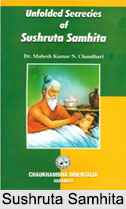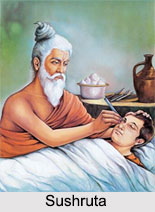 Sushruta Samhita is one of the oldest books in Ayurveda that was written by Sushruta, the legendary Ayurvedic Physician of ancient India. The Sushruta Samhita is the complete book that deals with the practical problems of surgery and midwifery or obstetrics. In India the practice of surgery is very ancient that dates back to around 800 BC. Surgery was termed as "Sastrakarma" and was one of the eight branches of Ayurveda, which is the ancient Indian system of medicine.
Sushruta Samhita is one of the oldest books in Ayurveda that was written by Sushruta, the legendary Ayurvedic Physician of ancient India. The Sushruta Samhita is the complete book that deals with the practical problems of surgery and midwifery or obstetrics. In India the practice of surgery is very ancient that dates back to around 800 BC. Surgery was termed as "Sastrakarma" and was one of the eight branches of Ayurveda, which is the ancient Indian system of medicine.
Sushruta: Composer of Sushruta Samhita
Sushruta is a figure of historical significance renowned for his contributions to ancient Indian medicine. The name Sushruta, which translates to "well heard," signifies his esteemed reputation as a scholar and healer. His legacy is primarily associated with the classical Indian medical text known as the Sushruta Samhita.
In the Sushruta Samhita, Sushruta is acknowledged as the author, although later manuscripts and printed editions present him as a narrator of the teachings he received from his guru, Divodasa. This revered figure by the name of Sushruta also finds mention in early texts like the Buddhist Jatakas. According to historical records, he was a physician who conducted his teachings in the ancient city of Kashi, modern-day Varanasi. Notably, Sushruta`s school of medicine in Kashi ran concurrently with another renowned medical institution situated in Taxila, along the Jhelum River. These events are believed to have occurred sometime between the years 1200 BCE and 600 BCE, marking a significant period in the history of Indian medicine.
The earliest explicit association of the name Sushruta with the Sushruta Samhita tradition is found in the Bower Manuscript, believed to date from the 4th or 5th century CE. This manuscript lists Sushruta as one of the ten sages residing in the Himalayan region, highlighting his stature as a prominent scholar and healer in ancient India.
Sushruta is recognized today as the "Father of Plastic Surgery" all over the world. He was the first person who studied human anatomy. Sushruta was the specialist of Rhinoplasty or plastic surgery and Opthalmology or the elimination of cataracts. He was equipped with excellent surgical skills and elevated the practical science of surgery to the level of art. 
Affiliation of Sushruta Samhita
The Sushruta Samhita, a significant ancient medical text, is closely affiliated with Hinduism in various aspects, as recognized by many scholars. Its affiliation with Hinduism is evident through several key elements within the text.
Hindu Terminology and Deities: The Sushruta Samhita employs terminology consistent with that found in more ancient Hindu texts. It explicitly mentions Hindu deities such as Narayana, Hari, Brahma, Rudra, Indra, and others in its chapters. This connection to Hindu deities reinforces its Hindu affiliation.
References to Hindu Scriptures: Throughout the text, there are references to the sacred scriptures of Hinduism, namely the Vedas. This inclusion of Vedic references highlights the text`s alignment with Hindu religious and philosophical traditions.
Treatment and Recovery Recommendations: In certain instances, the Sushruta Samhita prescribes exercise, walking, and the "constant study of the Vedas" as integral components of a patient`s treatment and recovery process. This integration of Vedic study into medical care underscores the text`s religious influence.
Incorporation of Hindu Philosophy: The Sushruta Samhita incorporates terminology from various schools of Hindu philosophy, including Samkhya. This philosophical integration reflects its grounding in Hindu thought.
Religious Ideas and Metaphors: Religious concepts permeate the text, such as the use of terms and metaphors that are pervasive in Hindu scriptures, particularly the Vedas. Additionally, the text delves into ideas related to Karma, the self (Atman), and Brahman (metaphysical reality) in a manner consistent with ancient Hindu texts.
Mythical Association: In Hindu tradition, Sushruta is revered as a descendant of Dhanvantari, the mythical God of medicine. Alternatively, he is seen as someone who received medical knowledge through discourse from Dhanvantari in the sacred city of Varanasi. This mythological connection further establishes the text`s deep-rooted affiliation with Hinduism.
Context of Sushruta Samhita
In the Sushruta Samhita this detailed study of anatomy is described. It consists of 184 chapters and is divided into two parts, The Purva Tantra and Uttara Tantra.
The Purva Tantra gives the signs and symptoms of important surgical diseases, obstetrics, geriatrics, anatomy, embryology, nature of poisons and their removal.
The Uttara Tantra gives account of various diseases of the ear, eye, head and nose and solutions to complications that may arise out of surgery.
Sushruta Samhita mentions about 1,120 medical conditions, including injuries and illnesses relating to ageing and mental illness. There are eight main divisions of human surgery in Sushruta Samhita namely;
Chedya (excision)
Lekhya (scarification)
Vedhya (puncturing)
Esya (exploration)
Ahrya (extraction)
Vsraya (evacuation)
Sivya (Suturing)
Content of Sushruta Samhita
The Sushruta Samhita stands as one of the most vital ancient medical treatises and holds a prominent place within the Indian medical tradition, alongside texts such as the Charaka-Sa?hita, the Bhe?a-Sa?hita, and the medical sections of the Bower Manuscript. This significant text encompasses a wide array of content and can be summarized as follows:
Scope: Composed subsequent to the Charaka Samhita, the Sushruta Samhita delves into numerous medical subjects that include General Principles, Pathology, Diagnosis, Anatomy, Sensorial Prognosis, Therapeutics, Pharmaceutics, and Toxicology. While there are areas of overlap with Charaka Samhita, Sushruta Samhita primarily serves as the foundational text for surgical practices within the realm of Indian medicine.
Chapters: The Sushruta Samhita, in its existing form, consists of 186 chapters, providing comprehensive descriptions of 1,120 distinct illnesses. Additionally, the text details information on 700 medicinal plants, 64 preparations derived from mineral sources, and 57 preparations rooted in animal sources.
Structural Divisions: The Sushruta Samhita is partitioned into two parts. The first five books, known as Sthanas, are regarded as the oldest segment of the text. The subsequent section, the "Later Section" or Uttaratantra, was incorporated by the author Nagarjuna. Each part encompasses diverse topics, with some subjects recurring in multiple chapters across different books.
Prevention vs. Cure: The Sushruta Samhita advocates a proactive approach to healthcare, emphasizing disease prevention alongside curative measures. It highlights the significance of physical exercise and hygiene in preventing diseases, although it also cautions against excessive strenuous exercise, which can be detrimental to health. Regular, moderate exercise is recommended to bolster resistance to illnesses and slow physical degeneration.
Human Skeleton: The text provides insights into the human skeleton, acknowledging a difference in bone count compared to other medical traditions. It recognizes a total of 300 bones, with variations in counts attributable to distinct schools of thought. The Sushruta tradition`s osteological system is grounded in the principle of homology, whereby body organs are perceived as self-mirroring and corresponding along various axes of symmetry.
Surgery: The Sushruta Samhita is particularly renowned for its detailed discussions on surgery, pioneering the practice of systematically examining deceased bodies to understand human anatomy—an innovative approach in its time. The text recommends practicing surgical techniques on objects resembling diseased or body parts, including squash, bottle gourd, and animal bladders. Surgical procedures described encompass a wide range, from haemorrhoidectomy to amputations, plastic surgery, rhinoplasty (reconstruction of the nose), ophthalmic procedures, lithotomy, and obstetrics.
Medicinal Herbs: The Sushruta Samhita, alongside other Sanskrit medical classics like the Atharvaveda and Charak Samhita, provides detailed information about over 700 medicinal herbs. These descriptions encompass aspects such as taste, appearance, digestive effects, safety, efficacy, recommended dosages, and therapeutic benefits.
Rhinoplasty: Of particular note, the text contains the earliest recorded method for cheek flap rhinoplasty, a surgical technique still in use today for reconstructing the nose. It offers more than 15 distinct approaches to nasal reconstruction, underscoring the text`s pioneering contributions to plastic surgery.
Social Significance: The Sushruta Samhita`s insights into rhinoplasty hold societal significance in India, as the nose is historically regarded as a symbol of dignity and respect. The availability of reconstructive surgery offered hope for individuals subjected to rhinotomy (nose amputation) as a form of punishment or branding, providing them with an opportunity for redemption and the restoration of breathing to normalcy.
Sushruta Samhita encompasses a wide array of medical knowledge, including surgical procedures, medicinal herbs, preventive healthcare practices, and anatomical understanding. Its enduring influence on the field of medicine is particularly notable, making it a foundational text in the rich tradition of Indian medicine.
Classification of Medicine in Sushruta Samhita
Sushruta details 650 drugs of animal, plant and mineral origin. He divided medicines into 37 classes. The medicines included in each class have certain common properties, such as acidity, sweetness, astringency, etc. He also described more than 300 kinds of operations that call for 42 different surgical processes and 121 different types of instruments.
Sushruta Samhita recorded the detailed description of the steps of operation and most amazingly the steps are followed in the modern plastic surgery even today.




















